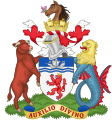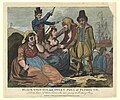The Devon Portal

Devon (/ˈdɛvən/ DEV-ən; historically also known as Devonshire /-ʃɪər, -ʃər/ -sheer, -shər) is a ceremonial county in South West England. It is bordered by the Bristol Channel to the north, Somerset and Dorset to the east, the English Channel to the south, and Cornwall to the west. The city of Plymouth is the largest settlement, and the city of Exeter is the county town.
Devon has a varied geography. It contains Dartmoor and part of Exmoor, two upland moors which are the source of most of the county's rivers, including the Taw, Dart, and Exe. The longest river in the county is the Tamar, which forms most of the border with Cornwall and rises in the Devon's northwest hills. The southeast coast is part of the Jurassic Coast World Heritage Site, and characterised by tall cliffs which reveal the Triassic, Jurassic and Cretaceous geology of the region. The county gives its name to the Devonian geologic period, which includes the slates and sandstones of the north coast. Dartmoor and Exmoor have been designated national parks, and the county also contains, in whole or in part, five national landscapes.
In the Iron Age, Roman and the Sub-Roman periods, the county was the home of the Dumnonii Celtic Britons. The Anglo-Saxon settlement of Britain resulted in the partial assimilation of Dumnonia into the kingdom of Wessex in the eighth and ninth centuries, and the western boundary with Cornwall was set at the Tamar by king Æthelstan in 936. (Full article...)
Selected article -
John Jeremy Thorpe (29 April 1929 – 4 December 2014) was a British politician who served as the Member of Parliament for North Devon from 1959 to 1979, and as leader of the Liberal Party from 1967 to 1976. In May 1979, he was tried at the Old Bailey on charges of conspiracy and incitement to murder his ex-boyfriend Norman Scott, a former model. Thorpe was acquitted on all charges, but the case, and the furore surrounding it, ended his political career.
Thorpe was the son and grandson of Conservative MPs, but decided to align with the small and ailing Liberal Party. After reading Law at Oxford University he became one of the Liberals' brightest stars in the 1950s. He entered Parliament at the age of 30, rapidly made his mark, and was elected party leader in 1967. After an uncertain start during which the party lost ground, Thorpe capitalised on the growing unpopularity of the Conservative and Labour parties to lead the Liberals through a period of electoral success. This culminated in the general election of February 1974, when the party won 6 million votes. Under the first-past-the-post electoral system this gave them only 14 seats, but in a hung parliament, no party having an overall majority, Thorpe was in a strong position. He was offered a cabinet post by the Conservative prime minister, Edward Heath, if he would bring the Liberals into a coalition. His price for such a deal, reform of the electoral system, was rejected by Heath, who resigned in favour of a minority Labour government.
The February 1974 election was the high-water mark of Thorpe's career. Thereafter his and his party's fortunes declined, particularly from late 1975, when rumours of his involvement in a plot to murder Norman Scott began to multiply. Thorpe resigned the leadership in May 1976, when his position became untenable. When the matter came to court three years later, Thorpe chose not to give evidence to avoid being cross-examined by counsel for the prosecution. This left many questions unanswered; despite his acquittal, Thorpe was discredited and did not return to public life. From the mid-1980s he was disabled by Parkinson's disease. During his long retirement he gradually recovered the affections of his party, and by the time of his death was honoured by a later generation of leaders, who drew attention to his record as an internationalist, a supporter of human rights, and an opponent of apartheid. (Full article...)General images
Selected image

Recently featured: Bigbury sea tractor - Crazywell cross - South Devon Cattle - Dartmoor tors – Plymouth harbour – Westward Ho! beach
Subcategories
Map
Related portals
Did you know...

- ... that Plymouth's lighthouse, Smeaton's Tower (pictured), was dismantled and then rebuilt on Plymouth Hoe as a memorial?
- ... that Devon is the third largest of the English counties and has a population of 1,109,900?
- ... that the name Devon derives from the name of the Celtic people who inhabited the southwestern peninsula of Britain at the time of the Roman invasion?
- ... that Devon was one of the first areas of England settled following the end of the last ice age?
- ... that the St Nicholas Priory in Exeter is being restored with the same methods that were used 500 years ago?
- ... that Devon is the only county in England to have two separate coastlines?
- ... that there was no established coat of arms for Devon until 1926?
- ... that the English Riviera Geopark in Torbay is the world's only urban Geopark?
Topics
WikiProjects
Associated Wikimedia
The following Wikimedia Foundation sister projects provide more on this subject:
-
Commons
Free media repository -
Wikibooks
Free textbooks and manuals -
Wikidata
Free knowledge base -
Wikinews
Free-content news -
Wikiquote
Collection of quotations -
Wikisource
Free-content library -
Wikiversity
Free learning tools -
Wikivoyage
Free travel guide -
Wiktionary
Dictionary and thesaurus














































































































